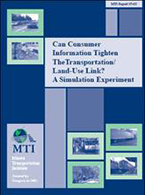- 408-924-7560
- mineta-institute@sjsu.edu
- Donate
Can Consumer Information Tighten The Transportation/Land-Use Link? A Simulation Experiment
Our results suggest two main findings: Providing bundled accessibility and housing information resulted in the selection of preferred locations that were closer to major destinations, as compared to the selections of individuals without access to the information; and individuals in the experimental group selected properties closer to transit lines that serve their destinations than members of the control group. Thus, providing housing seekers with information about their transit options from each unit may influence certain population subgroups to choose more transit-friendly locations than they would otherwise select. Our findings have implications for both the research and policy communities. At the level of public policy, the results suggest that information targeted towards individuals who are relocating can be used to enhance the attractiveness of locations that support multiple travel modes. Transportation and urban planners, health promoters, transit agencies, universities, and other institutions interested in promoting walking, bicycling, and transit use will find our results useful. For researchers, our results provide new evidence about how the connection between transportation and land use can be strengthened through policy attention that focuses on how transportation information can guide locational decisions.
DANIEL A. RODRIGUEZ, PhD
Dr. Rodriguez is an Assistant Professor in City and Regional Planning at the University of North Carolina, Chapel Hill. He holds a Bachelor of Science in business from Fordham University, a Master of Science in Transportation from the Massachusetts Institute of Technology, and a PhD in Urban, Technological, and Environmental Planning from the University of Michigan. His research focuses on the connection between transportation, land use, and activity. He recently coauthored the fifth edition of Urban Land Use Planning, to be published by University of Illinois Press in 2006.
JONATHAN LEVINE, PhD
Dr. Levine is Associate Professor and Chair of Urban and Regional Planning in the Taubman College of Architecture and Urban Planning at the University of Michigan. His interests are in transportation and land-use policy. He has completed two previous Mineta Transportation Institute projects: Developer- Planner Interaction in Transportation and Land Use Sustainability (with Aseem Inam and Richard Werbel), and Land Use and Transportation Alternatives: Constraint or Expansion of Household Choices? (with Aseem Inam, Richard Webel, and Gwo-Wei Torng). He recently completed a book on transportation and land-use issues, entitled Zoned Out: Regulation, Markets, and Choices in Transportation and Metropolitan Land Use, to be published by Resources for the Future Press in September 2005.
-
Contact Us
San José State University One Washington Square, San Jose, CA 95192 Phone: 408-924-7560 Email: mineta-institute@sjsu.edu






